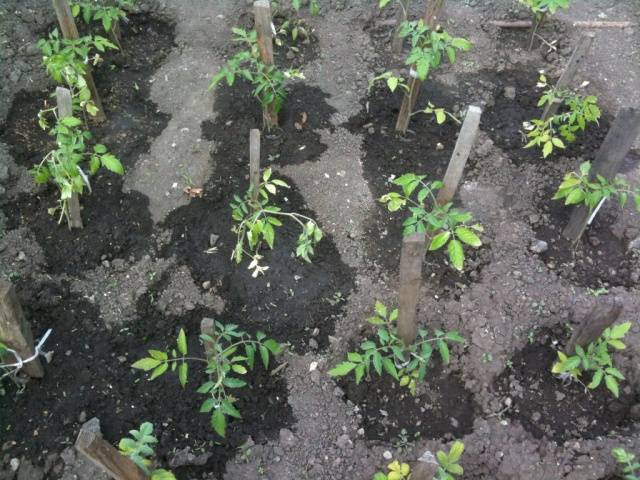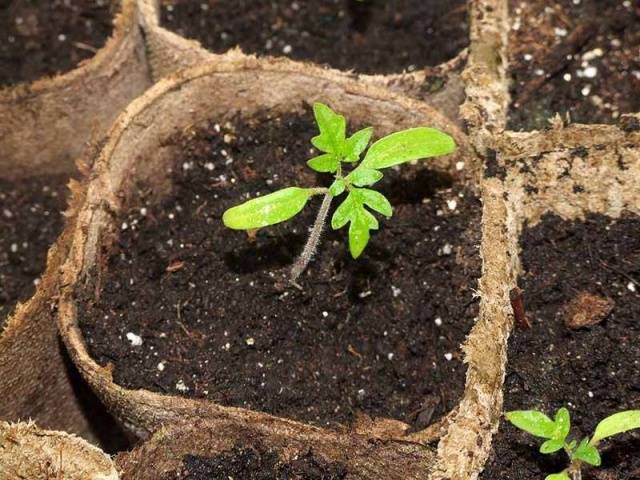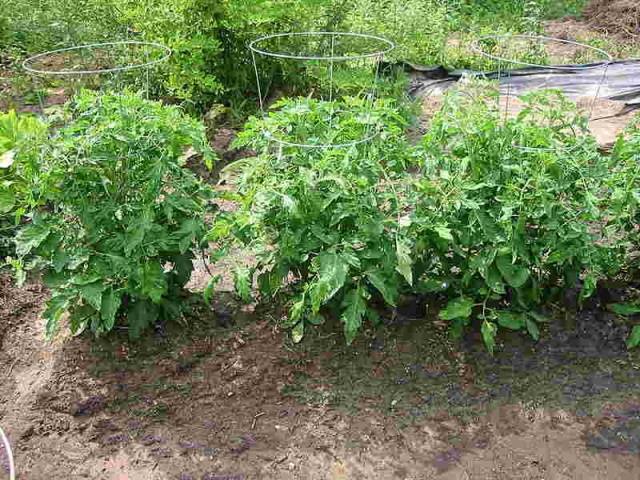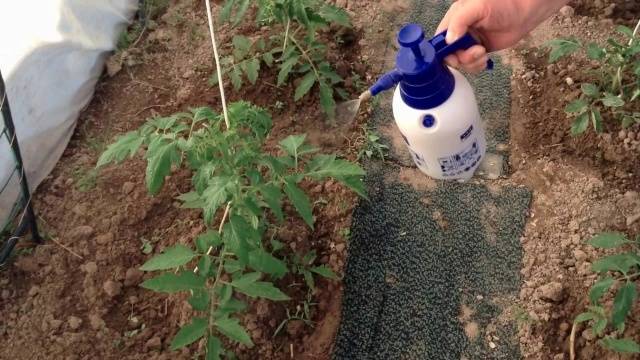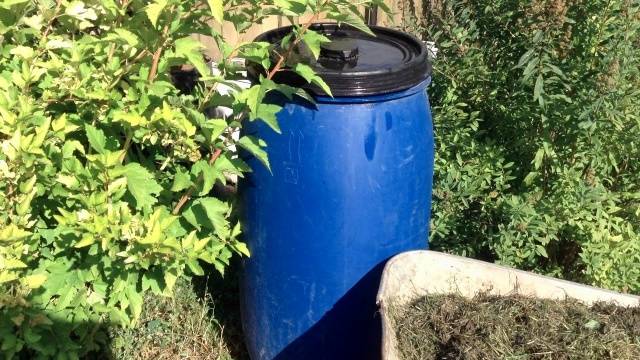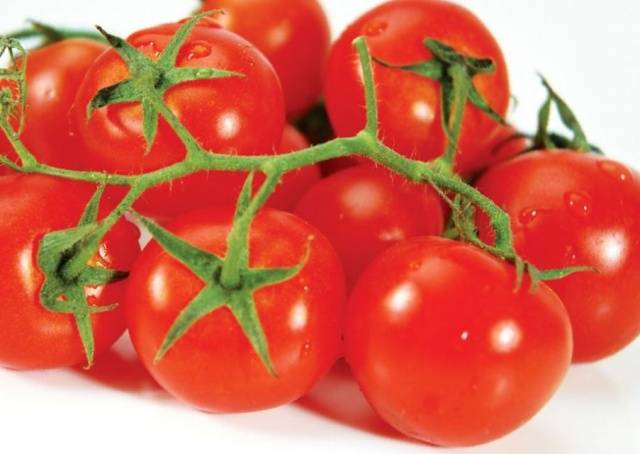Content
For growing high yields, timely fertilization for tomatoes is important. They will provide the seedlings with nutrition and will accelerate her growth and fruit formation. In order for tomato feeding to be effective, it must be done correctly, in compliance with the timing and amount of minerals.
The composition and frequency of use of fertilizers depend on several factors - the type of soil, the place of growing tomatoes, the state of the seedlings.
Soil preparation
Prepare the soil for tomatoes in the fall. When digging into the ground, add manure, humus, phosphoric and potash fertilizers. If the soil is loamy, it is necessary to add peat or sawdust. Sour - lime.
The table shows the proportions that should be observed when fertilizing for tomatoes:
№ | Name | Depth | Proportions |
|---|---|---|---|
1 | Humus | 20-25 cm | 5 kg / sq. m |
2 | Bird droppings | 20-25 cm | 5 kg / sq. m |
3 | Compost | 20-25 cm | 5 kg / sq. m |
4 | Peat | 20-25 cm | 5 kg / sq. m |
5 | Potassium salt | 20-25 cm | 5 kg / sq. m |
6 | Superphosphate | 20-25 cm | 5 kg / sq. m |
Trace elements required for tomatoes
The seedlings should receive all minerals in sufficient quantities. By its appearance, you can determine the deficiency of one or another element:
- with a lack nitrogen growth slows down, bushes wither, and tomato leaves become paler;
- fast-growing lush bushes indicate an excess of nitrogen and the need to reduce it;
- with a deficiency of phosphorus, the leaves become purple, and with an excess of phosphorus, they fall off;
- if there is too much phosphorus in the soil, and nitrogen and potassium not enough, tomato leaves begin to curl.
The main quantities of the necessary minerals are obtained by the plant from the root system, so they are introduced into the soil. The composition and amount of fertilizers vary depending on the stage of tomato growth, soil fertility and weather. For example, if the summer is cool and there are few sunny days, you need to increase the potassium content in top dressing for tomatoes.
Fertilizers
All known fertilizers for tomatoes are divided into two large groups. TO mineral include inorganic substances.
They have such advantages as:
- availability;
- getting a quick effect;
- cheapness;
- ease of transportation.
Of the nitrogen fertilizers for tomatoes, urea is usually used. It is introduced during nitrogen starvation of plants up to 20 g per well. It is better to choose from potash potassium sulfate, since tomatoes react negatively to the presence of chlorine. With a deficiency of potassium, its sulfate salt will be an excellent top dressing for tomatoes. Mineral substance - superphosphate is the best fertilizer for all types of soil.
Organic fertilizers are represented by manure, peat, compost, green fertilizers in the form of herbs. With the help of manure, trace elements and nutrients are introduced into the soil, and the plant mass contains potassium compounds, calcium, magnesium. Organic fertilizers promote healthy tomato growth.
Types of dressings
Top dressing of tomatoes is done in two ways. Root - consists in watering the bushes under the root with fertilizers dissolved in water.
When foliar feeding of tomatoes leaves and stems are sprayed with a nutrient solution. The concentration of the solution for treating bushes should be much lower. This method quickly saturates the seedlings with microelements and saves fertilizers. Spraying is carried out in small doses, but often. It is undesirable to use chlorinated water. Many summer residents prefer to collect rainwater.
Top dressing of seedlings before planting in the ground
The first feeding of tomatoes is recommended after the appearance of two leaves. Water the seedlings with a diluted urea solution.
After 7-8 days, the second feeding of the tomatoes is done - this time with bird droppings. Litter in half with water is kept for two days, and before use it is diluted 10 times. After such feeding, the seedlings will give good growth.
Before planting tomatoes, in 5-6 days, you can feed them again with a solution ash.
Top dressing scheme
Tomatoes need food and after planting in the ground, there should be three to four of them per season. You need to start after adapting the seedlings to new conditions - after about a week or two.
First feeding
To strengthen the roots, the formation of ovaries, phosphorus and potassium fertilizers are needed. It is better not to abuse ammonium nitrate, otherwise nitrogen will ensure rapid growth of seedlings and lush greenery, but at the same time the number of ovaries will decrease.
Many gardeners, instead of mineral fertilizers, prefer to use folk remedies for feeding tomatoes:
- some of the best are ash dressings - ash contains almost all trace elements useful for tomatoes;
- until the fruits are set, organic feeding of tomatoes with the help of bird droppings and manure is also useful;
- Herbal infusions will become an excellent liquid fertilizer - an infusion of young nettle gives a particularly good effect, since potassium, nitrogen and iron accumulate in its leaves.
What fertilizers are needed for tomatoes, each gardener decides for himself.
To disinfect the soil, the seedlings must be watered with a solution of pale pink potassium permanganate.
Folk remedies for feeding
An excellent stimulant for the growth of tomatoes is the infusion of eggshells. It is prepared simply, like all folk remedies. Crushed shells from three eggs are poured with three liters of water and infused until the smell of hydrogen sulfide appears. The solution is diluted and used for watering seedlings.
It is useful to feed tomatoes with yeast. Thanks to them:
- the soil under the tomatoes is enriched with beneficial microflora;
- the root system becomes more powerful;
- seedlings become more hardy and resist disease well.
The recipe for making a yeast solution is simple. You can use baker's yeast in briquettes, but dry yeast bags will work as well. Dissolve 2.5 teaspoons of the dry product in a bucket of warm water, add a spoon or two sugar and leave for 24 hours. Each bush is watered at the root.
Tomato yeast dressing goes well with ash or herbal infusion, but it should not be carried out more than twice a summer - the first time, about 14-15 days after planting the seedlings, and the second before flowering.
Easy to prepare and fertilize tomato from herbs. In a barrel or other spacious container, all the weeded grass from the beds, a small amount of nettle is folded and filled with water. To speed up fermentation, add a little sugar or old jam to the mixture - about two tablespoons per bucket of water. Then the barrel is covered with a lid or old bag until the end of fermentation.
The period of ovary formation
The timing of the second feeding of tomatoes is associated with the beginning of fruit formation. At this time, you can use a solution of Iodine - four drops in a bucket of water. Iodine will increase the resistance of tomatoes to fungal diseases, and also accelerate the formation of fruits.
You can prepare a complex top dressing for tomatoes according to the following recipe:
- Pour 5 liters of boiling water over 8 glasses of wood ash and stir;
- after cooling the solution, add ten grams of dry boric acid to it;
- pour ten drops of iodine and leave for 24 hours.
Before use, you need to dilute ten times and water the tomato bushes.
Complex feeding
According to the scheme for feeding tomatoes, the next treatment is carried out after a break of two weeks. A mixture is prepared for her, which contains all the necessary substances:
- in a large container, two-thirds of the crushed mass of nettle and dandelion with the addition of manure is laid;
- the container is filled with water and covered with a film;
- the mixture should ferment within ten days.
Before feeding the tomatoes, one liter of concentrate is taken in a bucket of water. Watering is done at the root - three liters per bush. To accelerate the ripening and improve the keeping quality of tomatoes, you can feed the tomatoes with comfrey infusion at the end of July.
Leaf spraying
If the seedling has a weak thin stem, a small number of small leaves and does not bloom well, foliar feeding of tomatoes will help well:
- yellow leaves with a lack of nitrogen can be removed with a dilute solution of ammonia;
- at the formation of ovaries seedlings are treated with a superphosphate solution;
- iodine solution with the addition of milk;
- boric acid;
- a weak solution of potassium permanganate;
- a solution of nitric acid calcium will help from rot on the tops of the bushes and from a tick;
- tomato seedlings are simply transformed by regularly spraying the leaves with a weak solution hydrogen peroxide in water, as their cells are filled with atomic oxygen;
- effectively combats late blight solution copper sulfate;
- if there is a lack of potassium, a three-day infusion of banana peel can be used as a fertilizer for tomatoes;
- an infusion or decoction is an excellent remedy against diseases onion peel.
As a top dressing for tomatoes, many gardeners prepare a product from several components - boric acid, copper sulfate, magnesia, potassium permanganate and shavings of laundry soap dissolved in water. Such a complex foliar dressing will enrich the tomatoes with essential minerals, strengthen the leaves and ovarieswhile disinfecting them from pathogenic microflora. To protect the leaves from burns, you need to dilute it.
Correct feeding
When fertilizing tomatoes, certain rules must be followed so as not to harm the bushes and get a greater effect from processing:
- the solution should not be too cold or hot, a sharp temperature drop should be avoided;
- each new product is first tested on one plant;
- it must be remembered that tomatoes do not like an excess of organic matter;
- feeding tomatoes should be done in the evening;
- you cannot root fertilizing tomatoes on dry soil, you must first water the bushes with just water, otherwise they may get burned;
- tomato leaves can also get burned when liquid fertilizers get on them.
Top dressing for tomatoes in greenhouses
In greenhouses, initial feeding tomatoes should be produced 15-20 days after transplanting. Liquid fertilizer is prepared by dissolving 25 g of urea and 15 g of potassium sulfate in a volume of 10 liters of water. Watering consumption is one liter per bush.
The second time tomato bushes are fed, with their massive flowering... Top dressing for tomatoes is necessary for the appearance of strong ovaries at the next stage. A tablespoon of potash fertilizer and half a liter of bird droppings and manure are consumed per bucket of solution. Each bush should receive up to one and a half liters of liquid. If there is a lack of organic matter, you can add a tablespoon of nitrophosphate.To prevent top rot on tomatoes, spray them with calcium nitrate - a tablespoon per bucket.
When the ovaries are formed, feeding the tomatoes is carried out with a solution of ash (2 l), boric acid (10 g) in a bucket of hot water. For better dissolution, the liquid is infused for a day. For each bush, up to one liter of solution is consumed.
Once again, fertilizer for tomatoes is used in mass fruiting to improve the taste of fruits and accelerate their ripening. For watering, a tablespoon of liquid sodium humate with two tablespoons of superphosphate is taken on a bucket.
The timing of feeding tomatoes can be adjusted depending on the climate, soil composition, and the condition of the seedlings. Each gardener decides for himself, based on his experience, which feeding scheme to choose. It is important to provide tomatoes with all the nutrients they need to get a rich and tasty harvest.



